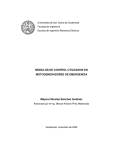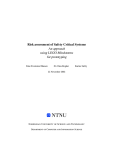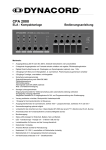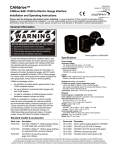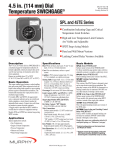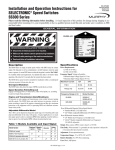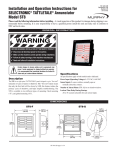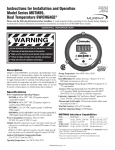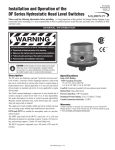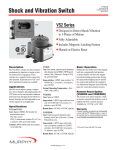Download AEG 6130 V-ma Specifications
Transcript
Autostart AS731/AS732 Generator Controller Installation Instructions mi6128 th revision G, 10 Sept 2007 catalogue section 75 Section A: Panel Installation and Wiring Please read the following information before installing. A visual inspection of this product for damage during shipping is recommended before installation. It is your responsibility to ensure that qualified mechanical and electrical technicians install this product. If in doubt, please contact your local Murphy representative. W A R N IN G Front facia BEFORE BEGINNING INSTALLATION OF THIS MURPHY PRODUCT nt i Disconnect all electrical power to the machine Make sure the machine cannot operate during installation Follow all safety warnings of the machine manufacturer Read and follow all installation instructions nu ed GENERAL INFORMATION co General 1. 2 line x 16 character backlit liquid crystal display 2. Operator control keys 3. Auto/manual mode LED indication is The Autostart AS731 and AS732 provide full-function, automatic or manual control for diesel generators. The fully programmable, microprocessor-based units include full measurement and display of engine and AC generator parameters, with a fully automatic fault protection and warning system. Facilities are also provided for remote monitoring and control via RS232 communication link and PC software; the AS732 additionally features an RS485 MODBUS RTU compatible link. This document details the panel mounting and electrical connection of AS731 and AS732 units fitted with firmware versions V1.00 through V2.x.x. Further details about specification, programming and operation may be found in the following documents:- ct D Rear facia Title ms6127 ms6343 mi6129 mi6243 AS731 bulletin AS732 bulletin AS731/732 installation B: programming AS731/732 installation C: AS730 to AS731/AS732 retrofitting AS731/732 operation AS731/732 and PC software model AS7CN AS732 RS485 MODBUS protocol du Doc. ref. ro mi6130 mi6131 mi6344 P MODBUS® is a registered trademark of AEG Schneider Automation Inc. 4. 5. 6. 7. FRANK W. MURPHY LTD. Church Rd, Laverstock, Salisbury, SP1 1QZ, United Kingdom tel: +44 1722 410055 fax: +44 1722 410088 email: [email protected] web: www.fwmurphy.co.uk Mounting clamps 2 x two part, screw terminal blocks, 1 – 20 and 21 - 30 RS232 communication port (RJ11 connector) (AS732 only) RS485 comms ports (2 x RJ45 connectors) FW MURPHY PO Box 470248 Tulsa, Oklahoma 74147, USA tel: +1 918 317 4100 fax: +1 918 317 4266 email: [email protected] web: www.fwmurphy.com In order to consistently bring you the highest quality, full featured products, we reserve the right to change our specifications and designs at any time. MURPHY, the Murphy logo, are registered and/or common law trademarks of Murphy Industries, Inc. This document, including textual matter and illustrations, is copyright protected by Frank W Murphy Ltd., with all rights reserved. © 2007 Frank W Murphy Ltd. GENERAL INFORMATION (cont.) Anti-static precautions Product specification The AS731/732 features sensitive electronic components that may be damaged by static discharge. Anti-static precautions must therefore be observed when storing, unpacking and handling:- Power supply: Operating voltage: steady state range crank brown-out Current consumption: standby (typ) cranking (typ) • Store the unit in the anti-static bags supplied • Use earthed wrist straps and anti-static mats when • Handle the unit by its external plastic casing. Except for connection purposes, avoid direct physical contact with the electrical connectors. Unpacking Inputs 3 – 5 Generator AC:operating voltage range 3 phase, 90 – 300 V AC rms L–N gen. volts display resolution 1 VAC gen. frequency measurement range 0 – 99 Hz. gen. frequency display accuracy <= 2% of full scale gen. frequency display resolution 1 Hz. Magnetic pickup: operating voltage range 2.5 – 25 V AC rms frequency measurement range 0 – 10 kHz. engine RPM display accuracy <= 2% of full scale engine RPM display resolution 10 RPM AC current sensing inputs: operating range designed for use with 5 Amp CT's primary ratings 10 to 5000 Amps For each unit ordered, the following is supplied:- • 1 x AS731 or AS732 module (model reference as listed on the rear label), including:¾ 2 x removable terminal blocks at the rear ¾ 2 x mounting clamps (one on each side of the case) nt i ¾ on AS732 units, 1 x network terminator module inserted into one of the RS485 ports. • These installation instructions communication lead, RJ11 to 9 way D type. • Model AS7CQ, 9 way to 25 way D type adaptor, for use with AS7CP. ct positive DC (switched relay) rated 16 A max. @ 24 V DC volt free SPNO relay 5 A max. @ 240 V AC negative DC (semiconductor) 500 mA max. @ 33 V DC Communications: RS232 port connector RS232 Baud rate RS232 max. lead length RS485 port connector RS485 Baud rate RS485 maximum network length RS485 protocol RJ11 9600 10 metres 2 x RJ45 9600 1000 metres MODBUS RTU Physical: Overall dimensions (W x H x D) Panel cut-out size (W x H) Weight Operating ambient temperature 144 x 96 x 162 mm DIN standard 140 x 92 mm approx. 770 g o –10 to +55 C P ro du (all ratings for resistive load) Start and fuel relays Programmable output 1 (default setting: gen. contactor) Programmable outputs 2 – 4 D RJ11 to 25 way D type. Outputs: is • Model AS7CR, RS232 modem communication lead, co Optional communication accessories include:- • Model AS7CP, RS232 local (null modem) 80% to 100% of battery positive –1V to +2V w.r.t. battery negative switch (open or closed) or analogue (Murphy, Datcon, VDO 5 or 7 bar), wired to negative DC open or closed to negative DC nu ed Inputs: DC inputs:positive input defined as: negative input defined as: Inputs 1 and 2 (oil pressure and engine temperature) handling and during installation. 5 – 40 V DC continuous to 0 V for >=100mS 95mA @ 12V, 55mA @ 24V 280mA @ 12V, 170mA @ 24V FWMurphy – AS731 / AS732 installation section A: panel installation and wiring th mi6128 revision G 10 Sept 2007 p2/6 PANEL MOUNTING 150 2. 1. 30 (typ) 3. 92 FRONT FRONT 140 D B C nu ed (mm) A Working behind the panel front, fit the two mounting clamps to studs on the side of the case. Locate each clamp on to the front stud (B), compress the clamp by pressing on the screw (C) and push the clamp upwards to locate on to the rear stud (D). Each unit is mounted in the front of a control panel through a DIN standard cut-out, 140 mm wide by 92 mm high. With the mounting clamps removed, insert the module through the front of the panel cut-out (A). The case extends to 150mm behind the panel front. An extra 30mm should typically be allowed for the connection of the wiring harness. With both clamps fitted, tighten the screwed pins (E) so that they move forward and secure the unit to the rear of the panel facia (F). The case design allows a panel thickness of up to 8mm. nt i ELECTRICAL CONNECTION co WARNING: DANGER OF INJURY OR DEATH. During normal operation, the AS731/AS732 is connected to high voltage AC circuits. Before connection, disconnection or handling DANGER ! of these units, ensure that all AC and DC power supplies are isolated. Connection to HIGH VOLTS or disconnection from live wiring may also cause damage to AS731/AS732 internal components. D is Electrical connection is at the rear of each unit, through a pair of two-part type screw terminal blocks labelled 1 - 20 and 21 - 30. Use a 3mm (1/8”) flat head screwdriver to loosen and tighten each screw terminal: to avoid excessive rotational force on the circuit boards, Murphy recommend that each connector block is removed from the unit before loosening or tightening individual screw terminals. Murphy make the following general connection recommendations:- External Slave Relays are a recommended connection on all outputs (as shown right), either to achieve the required load switching capability, or to reduce wear and tear on internal relay contacts. Slave relay and solenoid coils will naturally emit voltage spikes when de-energising, with the potential to cause faulty operation of, or damage to, electronic equipment. Suppress relay and solenoid coils at source, using the manufacturer’s recommended suppression network. DC coiled relays may also be suppressed using a reversed biased flywheel diode as shown right. Control panel other controls charger + battery Control panel Autostart other controls charger + Autostart RL1 Negative outputs:- + Autostart RL1 AC cabling & wiring harnesses P Minimise the effects of charger output noise by using separate wiring 1) between charger output and battery terminals (or starter motor star point) and 2) between battery terminals and panel DC supply rail. Autostart + + Autostart ro du ct Battery chargers Some battery chargers feature significant ripple and switching noise on the DC output. This electrical interference can be imposed on the panel power supply and control lines, with the potential to cause faulty operation of (and in extreme cases damage to) electronic control equipment. Positive outputs Separation of AC and DC wiring/harnesses is strongly recommended, in particular where AC circuits feature inductive/switched loads or high frequency noise, or where cable lengths above 5 metres are used. Autostart General battery FWMurphy – AS731 / AS732 installation section A: panel installation and wiring th mi6128 revision G 10 Sept 2007 p3/6 ELECTRICAL CONNECTION (cont.) Output 1 (pins 7 and 8) is a volt free, normally open contact (see specification for rating info). The default program action is set for ‘generator contactor’ control. A typical wiring diagram is shown in the panel on page 5. Specific terminal functions are as follows:- Terminal block 1 - 20 Outputs 2, 3 and 4 (pins 9, 10 and 11) are semiconductor outputs. Each output gives a negative DC signal when active (maximum rating 500mA), and is typically used to drive a remote slave relay: connect the relay coil between the output and positive DC, and suppress each coil with a flywheel diode or suitable suppressor network (as detailed left, and on the typical wiring diagram below). Negative DC power supply/ground Positive DC power supply Use a clean, noise-free DC supply between 5 and 40 V, normally the engine's 12V or 24V battery supply. The AS731/AS732 design is optimised for use with negative ground (earth return) systems, but may also be used with insulated (two wire) systems. These units MUST NOT be connected to positive earth systems. Pin 1 (negative DC) MUST be connected to ground/earth before connection of the RS232 communication port. WARNING: failure to connect pin 1 to negative DC / ground before connecting the RS232 port may result in damage to the AS731/AS732, PC or laptop. The wiring to the positive DC terminal (pin 3) should incorporate a 5 Amp anti-surge fuse. 12 Input 1: Low Oil Pressure (LOP) 13 Input 2: High Engine Temperature (HET) 14 LOP/HET return/ground These terminals allow connection of LOP and HET resistive senders or fault switches. Before use, the module must be programmed for use with the specific type of sender (Murphy, Datcon or VDO) or switch (open on fault or closed on fault). Resistive senders allow the Autostart to measure and display oil pressure and temperature. Senders also enable a pre-alarm warning as well as a shutdown response. For greatest accuracy and most reliable operation, two wire senders should be used. The sender should be connected between each input and the common return wire on pin 14. One wire (ground return) senders should not be used, since small amounts of noise on the ground/chassis can result in significant signal distortion and measurement error. Charge fail input A 'charge fail' condition occurs when this pin is switched to negative DC. Pin 2 may be connected to the WL terminal of a charge alternator (Autostart provides the necessary excitation current), or to the 'charge fail' output of a BC700 series charger, or direct to negative DC via relay contacts which close on fault. When used with a charge alternator, pin 2 may also be programmed to detect an ‘engine running’ condition. If a charge fail alarm is not required, leave pin 2 open circuit and program the ‘charge fail’ setting to ‘not used’. is co 2 Output 2 has default programming ‘common alarm’. The default setting of outputs 3 and 4 is ‘not used’. nt i 1 3 nu ed Pin Function D Fuel output Starter output These are positive DC outputs, rated to 16 Amps, for the control of engine (energised to run) fuel and starter motor circuits. Murphy recommend the connection of slave relays, with suppressed coils, between these outputs and the fuel and starter solenoids (see typical connection circuit on previous page). ro du 5 6 Positive DC (feed for relays)/Emergency stop Pin 4 is a positive DC feed for the Fuel and Start outputs (pins 5 and 6). If required, emergency stop switches (push to break, mechanically latching types) may be wired between positive DC and pin 4. ct 4 Program output (POP) 1a: Normally open contact Program output (POP)1b – Normally open contact Program output (POP) 2 – solid state, negative DC Program output (POP) 3 – solid state, negative DC Program output (POP) 4 – solid state, negative DC These outputs may be programmed to give one of 50 signalling and control ‘actions’, e.g. ‘preheat’, ‘engine running’, ‘overspeed fault’, etc. A full list of output ‘actions’ may be found in document mi6129. P 7 8 9 10 11 Fault switches allow the trigger of a simple shutdown response. A two-wire (insulated) switch should be wired between the input and pin 14. For earth return switches, leave pin 14 open circuit (to avoid ground loops). Further details of sender options and characteristics can be found in the AS731/732 programming literature, document mi6129. 15 Input 3 (programmable) 16 Input 4 (programmable) 17 Input 5 (programmable) These inputs may be used with remote contacts (open or closed to activate) to trigger a range of programmable ‘actions’, e.g. shutdown fault, warning fault, lamp test, manual start, manual restore (of mains supply), etc. (see document mi6129 for full programming details) The remote contacts should be wired between the input and battery negative. 18 Remote start/mains fail input Use this input to initiate an automatic engine start in AUTO mode. Connect the remote contact between pin 18 and battery positive DC. The input may be programmed to initiate a remote start on either an opening or closing contact. FWMurphy – AS731 / AS732 installation section A: panel installation and wiring th mi6128 revision G 10 Sept 2007 p4/6 ELECTRICAL CONNECTION (cont.) the automatic crank release, load switching and voltage/frequency/speed tripping. 19 Magnetic pickup positive 20 Magnetic pickup negative These terminals allow engine speed to be measured using a magnetic pickup. Pickup positive and negative output terminals should be respectively connected to pins 19 and 20. (Note: where the pickup head is isolated from the pickup body and ground, polarity of connection is not usually important.) The connection between pickup and Autostart should use a twisted pair and shield cable, with the shield connected to ground at one end only. The number of engine flywheel teeth must be programmed into the unit before it will correctly measure and display engine speed. A 1 Amp anti-surge fuse should be connected in series with each phase input (pins 21, 22 and 23). 25 26 27 28 29 30 Terminal block 21 - 30 Generator volts L1 Generator volts L2 Generator volts L3 Generator Neutral CT L1 CT L1 return CT L2 CT L2 return CT L3 CT L3 return These inputs are used to measure 3 phase generator current. Each input pair is designed for direct connection to a current transformer (CT) with a 5 Amp rated secondary coil. Where CTs are connected at a common star point, the star point should be commoned with pins 26, 28 and 30. nt i 21 22 23 24 nu ed Voltages are measured between each phase and the neutral terminal (maximum rating 300 VAC). The unit can however be programmed to display AC voltages as either phase to neutral or phase to phase. Voltages are displayed on the LCD, left to right, L1, L2, L3. The AS731/AS732 can also be programmed for use with 2 phase and neutral systems (leave pin 23 open circuit) and single phase systems (leave pins 22 ad 23 open circuit). WARNING: HIGH VOLTAGE DANGER OF INJURY OR DEATH. co • Ensure that all AC power supplies are isolated before connection, disconnection or handling. • Use fully shrouded wiring connectors on these terminals. is These terminals are used to sense the generator AC voltage and frequency, required for functions such as The CT primary coil ratio must be programmed into the Autostart before the unit will correctly measure and display AC current. A number of other programmable options allow the setting of generator over current warning and/or trip levels. Typical wiring diagram (AS731 automatic mains fail generator) generator contactor LOAD L1L2 L3 N D mains contactor L1 L2 L3 N L1 G L2 E L3 N N E R A T O R MCCB ct M A I N S L1L2 L3 N MCR1 UVR500 du MCR GCR GCR1 123456 +ve DC 5A fuse ro + A RPO2 RPO3 Emerg. Stop RPO4 WL magnetic pickup IP5 RST IP3 starter RFL IP4 fuel LOP inputs HET P – Autostart 731 21 1 2 3 4 5 6 7 8 9 10 11 12 13 14 15 16 17 18 19 20 22 23 24 1A 1A 1A 25 26 27 28 29 30 –ve DC FWMurphy – AS731 / AS732 installation section A: panel installation and wiring th mi6128 revision G 10 Sept 2007 p5/6 ELECTRICAL CONNECTION (cont.) Communication ports RS232 communication RS485 MODBUS communication To the right of terminal block 1 – 30, an RJ11 telephone type connector enables RS232 communication between the Autostart and a PC running Murphy software AS7CN. Model AS732 has two additional RJ45 connectors for RS485 communications, located at the top right of the rear facia (above the RS232 port). WARNING: failure to connect pin 1 to negative DC / ground may result in damage to the Autostart, PC or laptop. Inter-module RS485 communication is by daisy chaining units using RJ45 terminated 100BaseT Ethernet leads (CAT5E cable is recommended). A network terminator module (supplied with each unit) should be inserted into any unused ports (on those units at either end of the RS485 network). nu ed Before connection of this port, the negative DC supply terminal (pin 1) MUST be connected to ground/earth. For full details about the connection and operation of the communication systems and PC software, please refer to document reference mi6131. The PC may be connected to the port ‘locally’ via a short serial (null-modem) lead such a Murphy model AS7CP, or ‘remotely’ using modems and the telephone network. Communication networks Generator Site Modem Communications AS732 nt i Local Communications AS732 13 RS485 lead (100BaseT Ethernet, RJ45 - RJ45, CAT5 cable) AS732 AS732 RS485 ports (AS732 only) 13 RS485 ports (AS732 only) is 13 RS485 lead (100BaseT Ethernet, RJ45 - RJ45, CAT5 cable) co 13 AS731/732 RS232 Hayes AT compatible modem, DC powered (not supplied by Murphy) AS731/732 13 D 13 RS232 port (all units) – + PC du Software AS7CN AS7CP null modem (RS232) lead, RJ11 - 9 way D type ct Negative DC must be connected to ground/earth PC COM port RS232 port (all units) – + Negative DC must be connected to ground/earth Software AS7CN PC Software AS7CN PC ro AS7CQ optional 9 way to 25 way adaptor (for use with 25 way PC COM ports) P Generator Site FRANK W. MURPHY LTD. Church Rd, Laverstock, Salisbury, SP1 1QZ, United Kingdom tel: +44 1722 410055 fax: +44 1722 410088 email: [email protected] web: www.fwmurphy.co.uk AS7CR RS232 modem lead, RJ11 to 25 way D-type PC with internal modem PC with COM port Public Switched Telephone Network external modem, RS232 Hayes AT compatible (not supplied by Murphy) PC - modem lead (not supplied by Murphy) Remote Control Site FW MURPHY PO Box 470248 Tulsa, Oklahoma 74147, USA tel: +1 918 317 4100 fax: +1 918 317 4266 email: [email protected] web: www.fwmurphy.com In order to consistently bring you the highest quality, full featured products, we reserve the right to change our specifications and designs at any time. MURPHY, the Murphy logo, are registered and/or common law trademarks of Murphy Industries, Inc. This document, including textual matter and illustrations, is copyright protected by Frank W Murphy Ltd., with all rights reserved. © 2007 Frank W Murphy Ltd. FWMurphy – AS731 / AS732 installation section A: panel installation and wiring th mi6128 revision G 10 Sept 2007 p6/6






